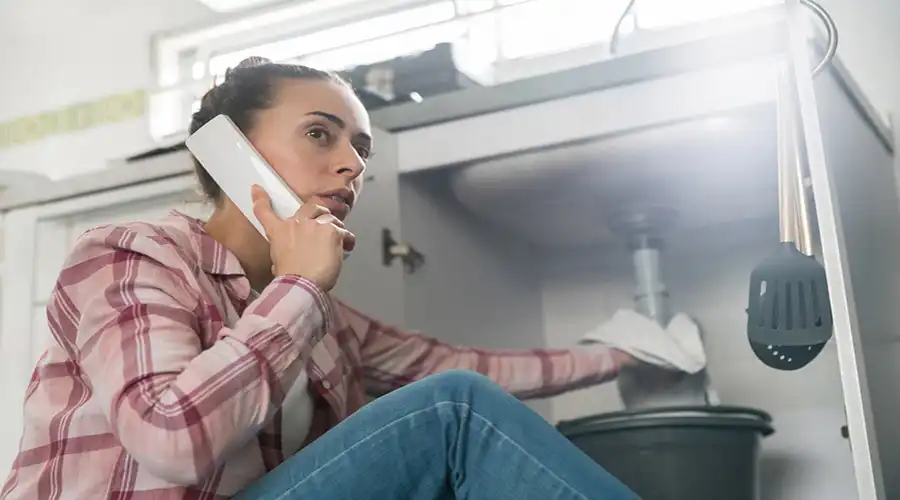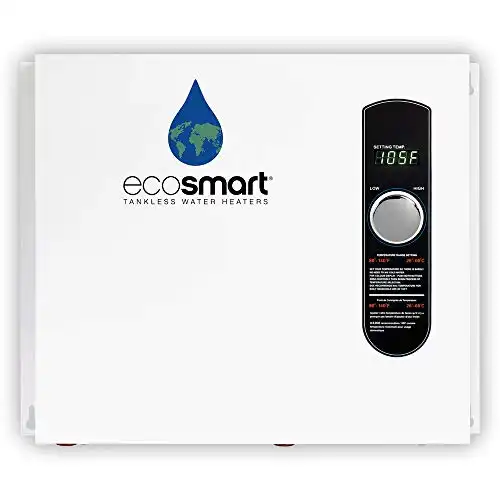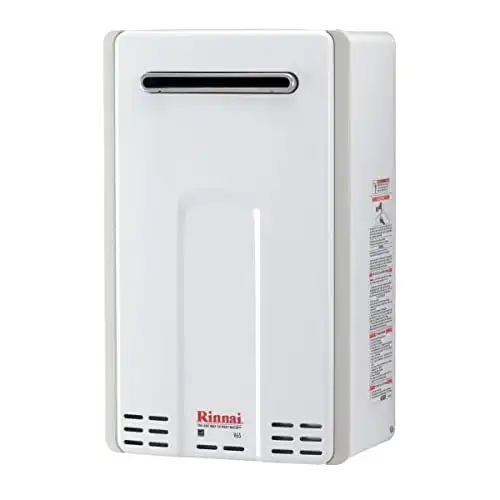
Tankless water heaters are the future of hot water use in residential homes and commercial properties. Tankless water heaters offer a compact design that produces hot water on demand. However, on-demand does not necessarily mean continuous.
Tankless water heaters, both electric and gas, have a hot water production capacity per minute or flow rate. If your family’s hot water demand exceeds the water heater’s production capacity, it can lead to no hot water.
When buying a tankless water heater, most people don’t know what size tankless water heater they need.
Tankless water heaters measure their flow rate in Gallons Per Minute (GPM). A family of 4 should look for a tankless water heater that can produce 7 gallons of hot water per minute. Most families use about 6.5 GPM during peak times.
To determine the tankless water heater size, you’ll need to know how many appliances your family will use simultaneously. A tankless water heater that produces 4 GPM can simultaneously supply one shower and one appliance.
Get FREE quotes from licensed Plumbers in your area today. Whether you need a new water heater, a sink repair, or a toilet fixed, We Can Help! All Plumbers are screened, licensed, and insured.
Tankless water heater size is essential for the upfront installation and operating costs. When a tankless water heater is undersized, it won’t produce enough hot water to meet your family’s demand. For example, Taking two showers and running a dishwasher can use up to 6.5GPM. A 4GPM tankless water heater can’t heat enough water to meet this hot water demand.
There’s no advantage to installing an oversized tankless water heater. A large tankless water heater carries higher installation costs and operation costs. There’s no advantage to installing an 8 GPM model when your family needs a 4 GPM model.
A 4 GPM tankless water heater costs between $400 to $700 plus installation, while an 8+ GPM tankless water heater costs $900 to $2000 plus installation costs.
Tankless water heaters are often referred to as demand water heaters. On-demand refers to having continuous hot water output for as long as the hot water tap is open. However, having multiple hot water taps open together will reduce the hot water output. Having too many hot water taps open at once will produce lukewarm water if the tankless water heater’s output capacity is exceeded.
According to Fixr.com, the average cost of a whole-house tankless water heater is $2,810 plus installation costs of $45 to $200 per hour with an estimated installation time of 2 to 8 hours.
We’ve created this comprehensive buying guide to help choose the right tankless water heater for your family. We will examine many factors you must consider when considering tankless water heaters.
Gallons of Hot Water You Need for a Tankless Water Heater
The first thing you’ll need to consider is how much hot water you’ll need your tankless heater to produce. We typically refer to this process as “sizing” the tankless water heater, but you will not use dimensional measurements to figure this out. Instead, you’ll need to look at two distinct metrics: flow rate and temperature rise.
Tankless Water Heaters GPM Flow Rate Explained
Peak demand refers to the time of day when you use the most hot water.
Tankless water heater sizing measures the flow rate in gallons per minute (GPM). Most tankless water heaters can produce between 2 and 10 gallons of water per minute. To determine your water flow rate requirement during peak demand times, you’ll need to add up the flow rates of all the fixtures and appliances in your house that might use hot water simultaneously.
You can only know your exact water flow rate requirement by checking your hot water appliance documentation. This list of typical flow rates for common fixtures and appliances should help you make an estimate, though:
| Fixture or Appliance Usage: | Average Gallons per Minute (GPM) Used |
|---|---|
| Bathtub | 4 GPM |
| Rain shower head | Up to 5 GPM |
| Standard shower head | 2.5 GPM |
| Standard dishwasher | 2.5 GPM |
| High-efficiency dishwasher | 0.5 – 1.5 GPM |
| Standard clothes washer | 2.5 GPM |
| High-efficiency clothes washer | 1.0 GPM |
| Sink faucet | 1.5 GPM |
As you see in this table, the standard shower head (2.5 GPM) uses about half the hot water as a rain shower head (5.0 GPM).
The kitchen faucet uses about the same hot water usage as other sink faucets, regardless of location. It’s rare for multiple sink faucets to operate together for long periods. Of all sinks, the kitchen sink faucet is likely used the most.
What is a Tankless Water Heater’s Temperature Rise
Once you’ve calculated the water flow rate during peak demand times your tankless unit will need, you need to figure out the required “temperature rise.” The temperature rise is the number of degrees your hot water heater will need to increase the incoming average groundwater temperature to provide sufficient hot water to your home.
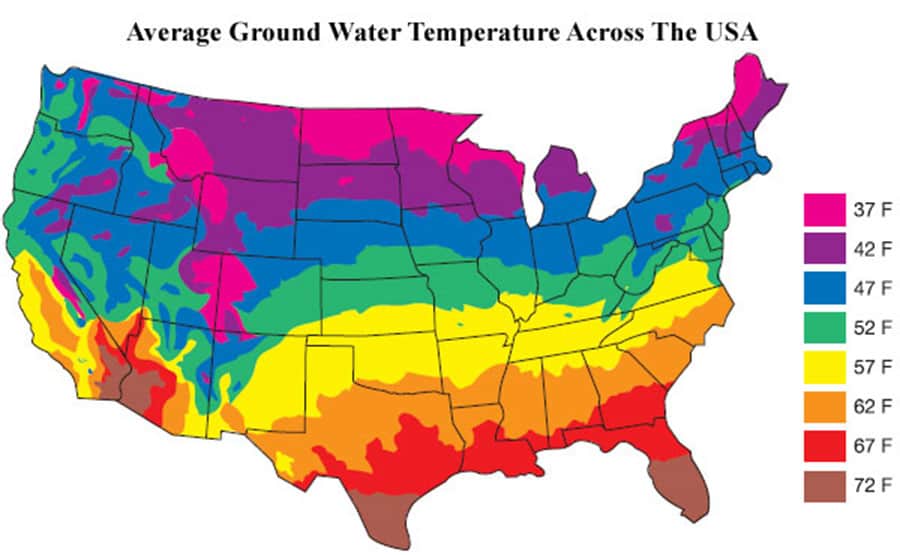
For example, say the temperature of incoming cold water is 52°F. You’ll need a temperature rise of 58°F to achieve 110°F hot water. So if 110° were the highest water temperature required by any of your hot water devices, you would need a tankless water heater that can produce a 58° rise in temperature.
Putting Flow Rate and Temperature Rise Together
Water heater ratings are in both flow rate and temperature rise. To properly size your water heater, you need to combine your required flow rate with the increase in temperature required.
| Ground Water Temperature | Expected Gallons per Minute Output |
|---|---|
| 37 F | 3.9 GPM |
| 42 F | 4.7 GPM |
| 47 F | 5.5 GPM |
| 52 F | 6.3 GPM |
| 57 F | 7.1 GPM |
| 62 F | 7.8 GPM |
| 67 F | 8.6 GPM |
| 72 F | 9.4 GPM |
Here’s another example. Say you have four devices that might simultaneously require hot water:
- Hot water faucet: 1.5 GPM / 110°
- Dishwasher: 1.5 GPM / 110°
- Washing machine: 2.0 GPM / 120°
Let’s also assume your incoming cold water temperature is 50°. To run all these devices simultaneously, you need a tankless water heater with a flow rate of 5.0 GPM and a temperature rise of 70°. The 5.0 GPM flow rate is the sum of all device flow rates. The 70° temperature rise comes from subtracting the incoming water temperature (50°) from the highest device water temperature (120°).
Just because your device’s combined flow rate adds up to 5.0 GPM doesn’t mean you need a water heater with a flow rate of 5.0 GPM. If you don’t plan on using all your hot water devices simultaneously, you can get away with buying a less expensive heater with a lower flow rate.
Are Tankless Water Heaters Worth the Cost
When considering a tankless water heater, people often wonder whether it’s worth the cost.
Unlike tank water heaters, tankless water heaters are worth the cost due to the increased lifespan, reduced maintenance, and continuous hot water on demand.
- Tankless water heaters can last over 20 years, whereas tank water heaters can fail in as little as 8 years.
- Tankless water heaters don’t have a tank that can fail and leak, reducing the risk of water damage.
- Tankless water heaters have no tank to maintain. Tank models require annual flushing maintenance to preserve the tank, which is often overlooked, contributing to the reduced lifespan.
- Tankless water heaters can provide hot water on demand. A 50-gallon tank water heater can become exhausted in as little as 30 minutes of continuous use and requires a minimum of one-hour recovery.
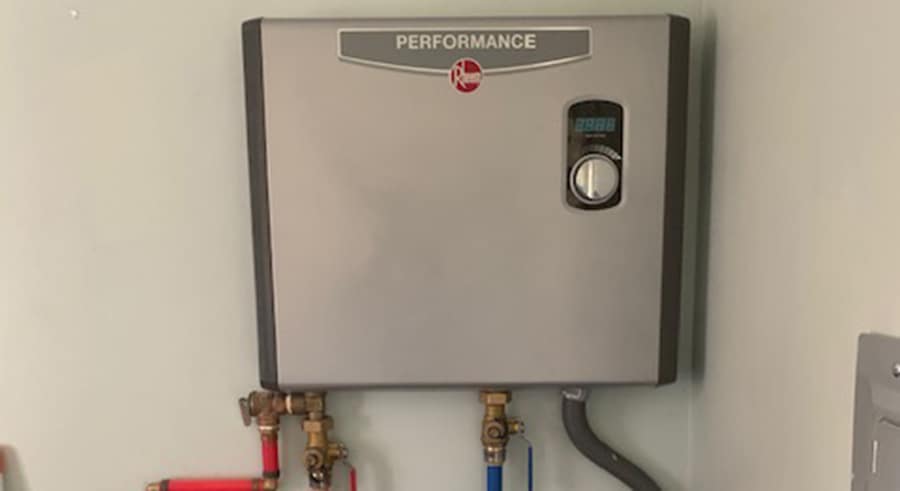
Electric vs. Gas Tankless Water Heaters
Once you’ve determined the required flow rate and temperature rise, you’ll need to decide between electric and gas tankless water heaters.
Electric Tankless Water Heaters Cost Less to Buy and Install
One of the primary benefits of buying an electric tankless water heater is that they are less expensive than its gas-powered counterparts. Whole-house electric models typically cost between $500 and $700, while whole-house tankless gas water heater models cost $1,000 to $1,200+.
The cost of installing an electric tankless heater is significantly less than installing a gas-powered tankless heater. Once you’ve confirmed your home’s wiring is compatible with the model you’ve chosen, installing the electric heater is relatively quick.
You should note that electric tankless water heaters may require some electrical upgrades. Some electric water heaters require up to 4 – 220v breakers to operate, significantly raising installation and operation costs.
Installing a gas-powered heater can incur some higher upfront costs. For starters, you’ll need to install a ventilation system to eliminate the carbon monoxide your water heater emits. There are also many safety and inspection costs you need to consider, such as confirming the size of your gas line and ensuring an adequate supply of fresh air.
Electric Tankless Water Heaters are Easier to Maintain
Electric units cost less than gas-powered units because they are simpler devices. There are fewer components inside, which means fewer moving parts can break down and require expensive repair.
When a repair is needed, you’ll typically pay less than if you were repairing a gas-powered unit. Most tankless water heaters will beep to notify you when tankless water heater maintenance is needed.
Electric Tankless Water Heaters are More Energy-Efficient
The best gas-powered tankless heaters tap out at about 85% energy efficiency. An 85% efficiency rating is pretty poor compared to most electric models, averaging 98% energy efficiency. So even if natural gas is cheaper than electricity in your area, you might still save money on energy costs by going with an electric unit.
Electric heaters are more environmentally friendly. Producing electricity is already less harmful to the environment than burning natural gas is, and the increased energy efficiency of electric models only adds to the difference in impact.
Electric Tankless Water Heaters Can Require Significant Electrical Upgrades
The most significant disadvantage of electric tankless water heaters is the installation. Electric tankless water heaters require one 240v breaker for each burner. Large GPM models require three or four 220v breakers to operate, meaning you may need to add an electrical subpanel or other electrical upgrades.
If you opt for a high output electric tankless water heater, you may have to install a new sub-panel to power the water heater. If you require three 240v breakers, you’ll need six breaker slots to power the unit. For four 240v breakers, you’ll need eight breaker slots. Therefore, if your current electrical panel does have enough open spaces, you’ll need to install a new sub-panel.
On average, in an electric tankless unit, you can estimate you’ll need one heating element for every 2GPM of water output.
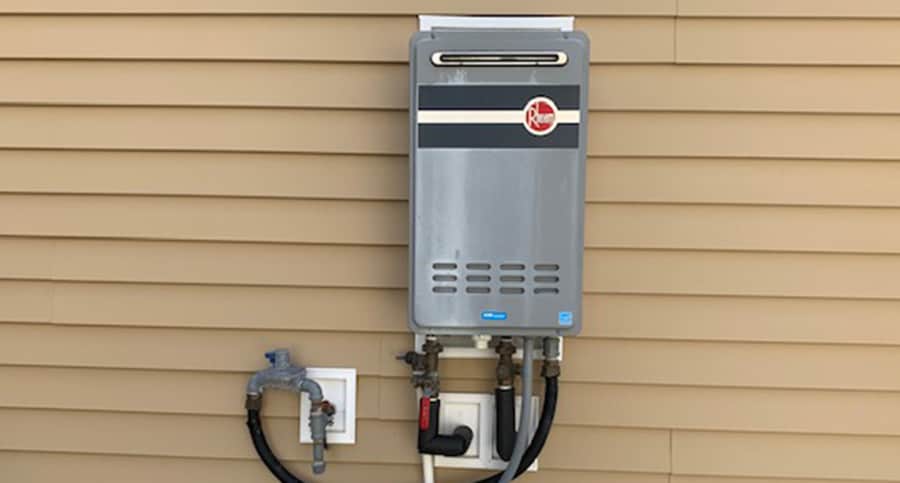
Gas Tankless Water Heaters Produce More Hot Water
Tankless gas water heaters have both natural gas and propane models. Some buyers choose a tankless gas water heater over an electric one because gas models can support higher flow rates. The best electric units max out at 8GPM, while some gas models can go significantly higher. If you need a tankless heater for a large household or some industrial purpose, you may have no choice but to use a gas-powered option.
There are some stark differences when examining gas-fired and electric water heaters. Most on-demand tankless water heating units can operate at various inlet temperatures.
A typical 70 degree Fahrenheit (70° F) increase will produce 5 gallons of hot water per minute in hot water output from a gas-fired model. In an electric model, the same 70 degrees Fahrenheit (70 ° F) increase will produce about 2 gallons of hot water per minute in hot water, which is a significant reduction.
Natural Gas is Cheaper than Electricity in Some Areas
Depending on where you live, the discrepancy in price between natural gas and electricity might make it enticing to go with a gas-powered model. However, even if natural gas is significantly cheaper than electricity, the increase in efficiency with electric models and the forecasted increase in natural gas prices might still make going electric the better option.
Rinnai is a leader in gas tankless water heaters. This unit is installed outside and can produce up to 6.5 GPM of on-demand hot water.
Indoor or Outdoor Installation Options
Unlike a traditional tank-style water heater, which you install indoors, you can install tankless water heaters indoors or outdoors.
The main benefit of installing your tankless water heater outside is that you don’t need to install a venting system. Electric units don’t require ventilation, so outdoor installation is no real benefit.
You can install a tank-style water heater outside in warmer climates, but you still need to build an enclosure. Mounting your tankless water heater outdoors is typically reserved for warmer climates where the temperature doesn’t drop below freezing too often. Most outdoor tankless water heaters have built-in freeze protection as low as -30 degrees Fahrenheit.
Conclusion
You might not think about it often, but you use your water heater daily. It’s the one appliance that helps keep things clean and running smoothly in any household providing hot water as needed! The question is, how do you pick out the right size tankless water heater for your family?
Take into account what you will use appliances simultaneously. For instance, if two people living in an average-sized home need to shower at different times of the day (perhaps because they work opposite shifts), then a 2 GPM model would suffice.
On the other hand, if four people live together and want to shower or run multiple appliances at once – like washing dishes or doing laundry while taking showers – your need will be about 6.5 GPM during peak usage.
Get FREE quotes from licensed Plumbers in your area today. Whether you need a new water heater, a sink repair, or a toilet fixed, We Can Help! All Plumbers are screened, licensed, and insured.


